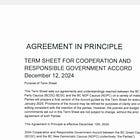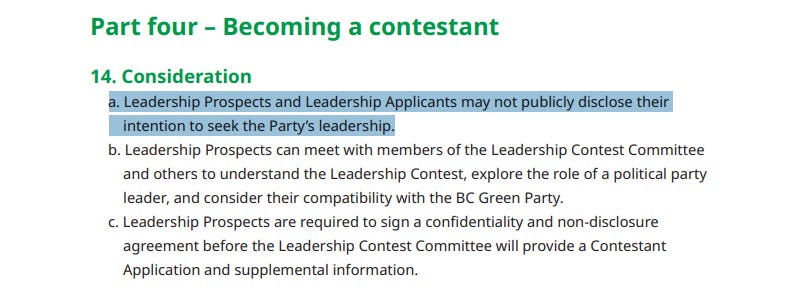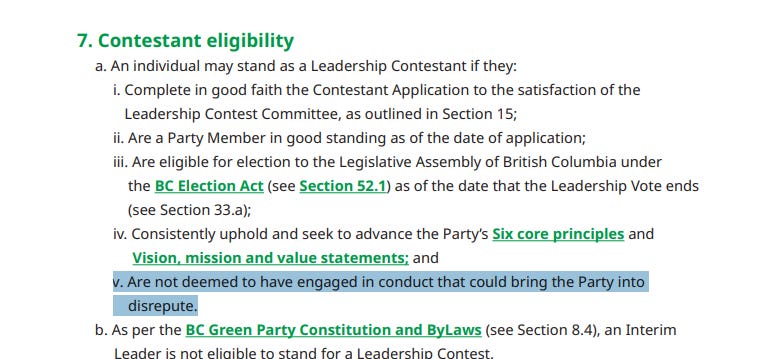Why is no one running to lead the BC Greens?
With less than three weeks to the cut-off, not a single person has announced their intention to run
Despite a disastrous drop in support in the fall election, the BC Greens are still a significant force in British Columbia politics thanks to the narrow, bare majority the NDP government currently holds. The two-man Green caucus has a confidence and supply agreement with the government, which gives them influence over legislation and priorities.
The party opened applications for the top spot on February 27th. The cut-off for candidates to run to lead the province’s third party is in less than three weeks, on May 31st*. After several months, and with such a short time frame left, it is surprising that not a single potential leader has announced their intention to run.
*Shortly after this post was published, the BC Greens website was updated to extend the deadline for candidates to apply to June 14th.
In the last leadership race for a British Columbia party — the 2022 BC Liberal leadership race — the first candidate, Ellis Ross, announced his intention a full 9 months and 12 days before the cut-off. Kevin Falcon, who won the position on the fifth ballot, announced his intention on May 17, 2022 — six months and 13 days before the deadline. This meant a long, robust leadership campaign between the seven candidates, giving them and their party regular media attention and an increase to their political profile.
While the lack of attention to the BC Green race may give the impression that no one wants to lead the party, the leadership contest rules may also be part of the problem — candidates are not allowed to tell anyone they’re planning to run.
Since announcing their intention to seek the leadership would disqualify a candidate from seeking the leadership, the party has effectively banned anyone from bringing attention to the race. This also prevents a candidate from building a media profile, soliciting donations or recruiting volunteers until the party says so.
The cut-off to become a member to vote in the race is August 10th, leaving only three months from today for candidates to sign up new members. For a party that has been seeing declining fundraising and an even sharper decline in support, it is surprising to see them limit opportunities to expand their membership base.
Another barrier to entry is the money a candidate will need to pay to the party. A leadership candidate must pay an initial $1000 application fee, provide a $5000 deposit, and then pay $15,000 in three installments over the brief campaign period. Since candidates cannot tell anyone they are running, their ability to proactively fundraise to pay these dues is severely hampered. Candidates also need to give the party 25% of any money they raise, and individuals are limited in how much they can donate.
A further clause may give potential applicants pause — “Leadership Campaigns must agree to support the successful Leadership Contestant as leader of the BC Green Party.” Being that competitive races often lead to disagreements, it is entirely possible that an unsuccessful candidate may not feel themselves aligned to the party depending on who wins. Agreeing in advance that their whole team will support whoever wins — without knowing who is even running — is a leap of faith few would take with a party that collapsed only a few months ago.

The party has also given itself wide, sweeping powers over any candidates that seek to lead the organization. The Leadership Contest Committee included in the rules the ability for themselves to exclude any candidate who has “engaged in conduct that could bring the Party into disrepute” — a provision that is broad enough to allow the party to exclude pretty much anyone they don’t want. The Committee can also mandate required workshops candidates must attend, limit and screen all mass communications, impose fines and even expel the candidate, their financial agent and campaign manager as members of the party.
For someone determined to lead British Columbia’s political environmentalist movement these can be overcome, but they take the reigns at a difficult time. The party has been declining in every election since their breakthrough in 2017, and did not come close to running a full slate of candidates last fall. The next leader will have a lot of building to do.
It’s entirely possible that none of these rules are a problem at all — it’s just no one wants the job.







I'm baffled that neither of the sitting MLAs have stepped up since it's generally a huge edge for the party leader to have a seat - both for the leader and the party. I'm assuming you know the players so... any insights on this one?
'though that disclosure rule is... let's go with bizarre... why would anyone decide to run for any office ever if they're not allowed to gauge potential support? 100% guarantee that anyone who steps up (other than one of the sitting MLAs) will have violated this rule and will magically have a campaign team and backers together within seconds of announcing.
And agreeing to support the potential leader... uh... sure...
For the sake of argument, let's say Andrew and Sonia both decided they wanted the job back... Or, this'd be fun, Chip Wilson thinks it'd be cool to run a party... Namaste?
"She's dead, Jim."